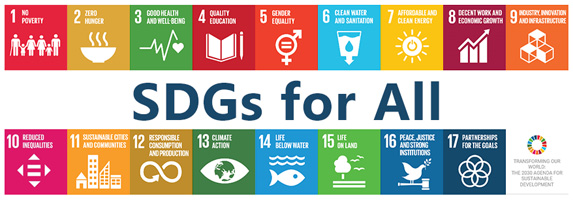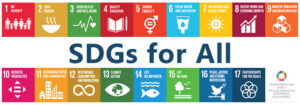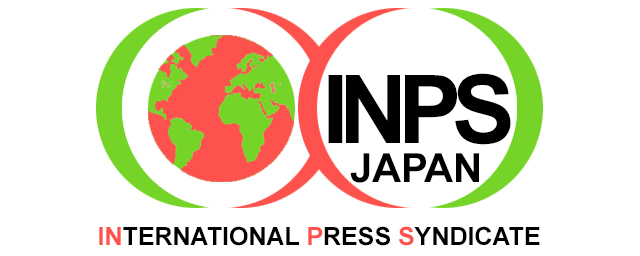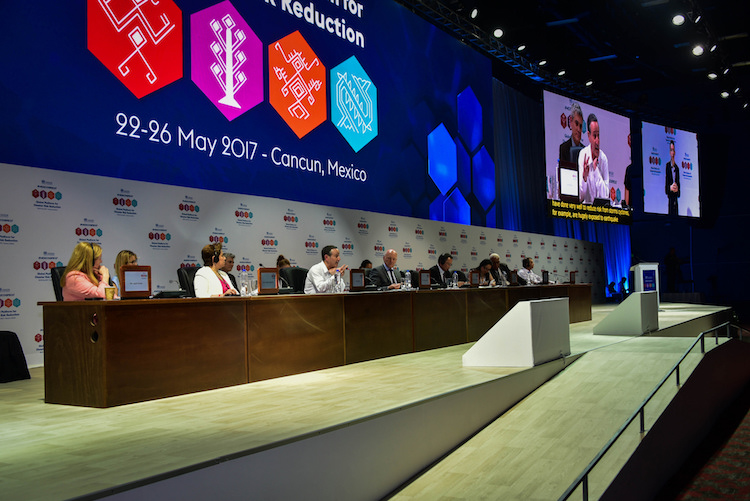By Ek Soria
MEXICO CITY (IDN) – The 2017 Global Platform for Disaster Risk Reduction conference, held in Cancun from May 22 to 26, brought together disaster risk managers, policy makers and leaders from the private, scientific and civil society sectors to discuss the commitments of States to absorb, adapt to and recover from disasters in a timely and efficient manner.
High on the agenda was assessment of global progress in implementing the Sendai Framework for Disaster Risk Reduction adopted in Sendai, Japan, in 2015 as a 15-year, voluntary, non-binding agreement which recognises that the State has the primary role to reduce disaster risk but that responsibility should be shared with other stakeholders including local government, the private sector and other stakeholders. |JAPANESE
The Sendai Framework aims for the “substantial reduction of disaster risk and losses in lives, livelihoods and health and in the economic, physical, social, cultural and environmental assets of persons, businesses, communities and countries.”
The Cancun meeting was presented with a series of country reports on implementation of the Sendai Framework in which the need for participation of communities of people who are those affected by disasters in the most direct – and often dramatic – way was highlighted.
Participants heard calls for recognition of the role of marginalised and vulnerable people in filling gaps in disaster risk planning and mitigating damage, not least because they are also excluded in the broader field of development.
These people should be at the forefront of sessions discussing disaster risk reduction, according to Madeleine Redfern, mayor of Iqaluit, capital of the Canadian territory of Nunavut.
“The strongest message that has been sent is that we cannot afford the luxury of excluding,” said Redfern. “People must not be ignored. We have to go beyond, where women, indigenous people … participate. There is so much knowledge, so much desire to participate that they cannot be ignored. Their involvement at national or international level for disaster risk reduction is important. Otherwise our plans will not be effective.”
Participants stressed that only by doing this would the proposals of the Sendai Framework be matched by progress on the ground.
The framework calls for a substantial reduction in mortality as a result of disasters by 2030, as well as a decrease in economic losses and damage to critical infrastructure and basic services, including health and education.
Speakers noted that, almost two years after the Sendai Framework formulated goals and deadlines, some communities have learned to deal with disasters but there are still regions where chronic vulnerability caused by underdevelopment restricts the scope of institutions to cope with disasters in the future.
The Sendai Framework aims to prevent the emergence of new risks of disaster, reduce existing risks, increase preparedness for response and recovery, and strengthen resilience by implementing integrated and inclusive measures of an economic, structural, legal, social, health, cultural, educational, environmental, technological, political and institutional nature.
However, most of the countries and regions suffering the greatest impact of climate change face tasks that represent a major challenge.
From commitment to action
With the first session of the Cancun meeting dedicated to assessing the Global Platform, speakers also referred to other commitments signed by States – such as the 2005 Kyoto Protocol and the 2016 Paris Agreement, both within the framework of the United Nations Framework Convention on Climate Change (UNFCCC) to agree and establish binding measures for the reduction of greenhouse gas emissions – which are necessary for recognising the real scope of prevention.
While the guidelines and priorities for action of the Global Platform include the strengthening of governance to manage and reduce risk, and to enable an effective response in the field of recovery, rehabilitation and reconstruction, solvency is required for countries to be able to do so. “Insurance is not the only solution, nor the best,” said Ingrid Hoven, Director-General, Department for Global Issues – Sector Policies and Programmes at the German Federal Ministry for Economic Cooperation and Development (BMZ). “How do we generate the best conditions for reducing the risk of people staying in poverty?”
Governance understood as the interaction of public administrations with the market and the private sector or so-called civil society organizations requires greater coherence in the field of disaster risk reduction at a global level. “There can be no fulfilment of the objectives of sustainable development at the speed with which losses are being generated by disasters,” according to Saber Chowdhury, President of the Inter-Parliamentary Union
While current indicators show that disasters are greater than the production of wealth, participants called for taking advantage of the momentum of similar meetings to create agendas with actions truly committed to full engagement between all levels of parliaments and social groups in order to reach agreements that would allow greater coherence. [IDN-InDepthNews – 30 May 2017]
Photo: The 2017 Global Platform for Disaster Risk Reduction conference was held in Cancun, Mexico, from May 22 to 26. Credit: UNISDR




